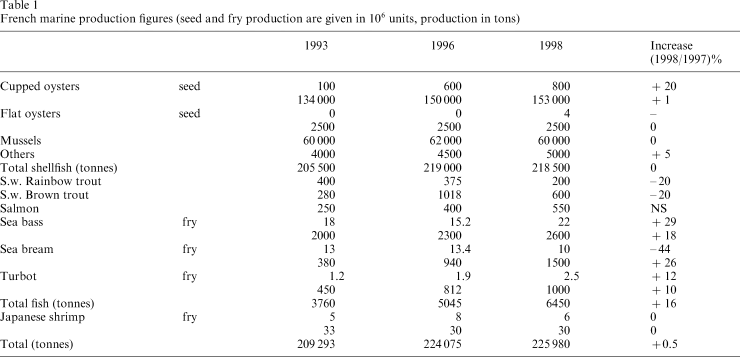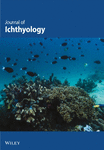Regulation and monitoring of marine aquaculture in France
Summary
Shellfish farming, with cupped oyster (Crassostrea gigas) as principal species dominates marine aquaculture production in France. Fish production is presently the only expanding marine production sector, mainly in the Mediterranean coast of the country. Shellfish and finfish farmers must obtain a permit in order to use maritime public property. Finfish farmers have to obtain operating authorization, as fish farming is considered by law to be an activity liable to pollute. Each of these two licensing procedures is time consuming and costly. Specific observation networks, aimed at determining the sanitary quality of the shellfish production basins, are operated by the French Institute for Marine Research (Ifremer). Monitoring the impact of aquaculture operations is handled by the Veterinary Services, which utilize the data originating from monitoring undertaken by the farmers themselves. There is a place for implementation in French legislation, in order to harmonize regulations with those set by the European union. Further, rules could be adjusted along with the procedures in order to respond to actual risks commonly encountered. The level of adjustment could efficiently be determined by estimating holding and carrying capacities of the area for both shellfish and finfish.
Introduction
France is one of the main European producers of marine aquaculture products (ICES 1999). For a long time, aquaculture production was regulated by specific laws, linked to public property. They have recently been implemented towards a greater environmental concern due to pressure from the European Union. The regulations apply to the two major groups of French produce: fish and shellfish. Given their biological specificity, these two branches of the aquaculture industry are still subject to different sets of environmental regulations, some of which will be adjusted as needs require.
Aquaculture production in France: nature and scale
The trend of the French marine aquaculture production figures during the past decade is detailed in Table 1. Production is dominated by the cupped oyster (Crassostrea gigas), around 150 000 tonnes of which are produced each year corresponding to an annual turnover of 213 million Euros. The major production sites are located on tidal flats along the Atlantic coast (Normandy, Brittany, Charentes). Total shellfish production has been quite stable over the past 10 years, fluctuating around an average of 210 000 t per year. Fish production increased by 16% during the 1993–98 period and amounted to 6500 t in 1998, with sea bass (Dicentrarchus labrax) and sea bream (Sparus aurata) farmed in sea-cages along the Mediterranean coast (3000 t, value about 30 million Euros). Land-based marine fish farms are developing and France is also specializing in fry production, both for shellfish and fish. France is presently the European leader in term of output of sea bream and turbot (Psetta maxima) fry production (which are provided to grow-out units) targeting export markets. In terms of direct employment the aquaculture sector represents a total of about 12 000 jobs.
Description of the regulatory procedures for setting up a production site
There are two main procedures for obtaining permission to set up an aquaculture site in marine waters (Dosdat et al. 1993; Morice 1995): a permit which allows the holder to use maritime public property (all land below sea-level belongs to the State) and the operating authorization for all activities likely to impact on the environment. The latter applies to fish farming only and is not presently required for shellfish leases.
The permit
Figure 1 summarizes the procedure for licensing which applies to intended installations of floating rafts, water intake and output devices in land-based units, as well as fixed structures on tidal flats. The permit lists the species farmed, the level of production, the location and some general specifications of the operation. Some additional conditions can be added, most of which concern the type and extend of the monitoring required. The permit is subject to paying a fee, the price of which depends on the size of the activity (for example 8.4 Euros per 100 m2 for fish and 2.3 Euros for shellfish) and not on the actual production value). Some general comments can be made:
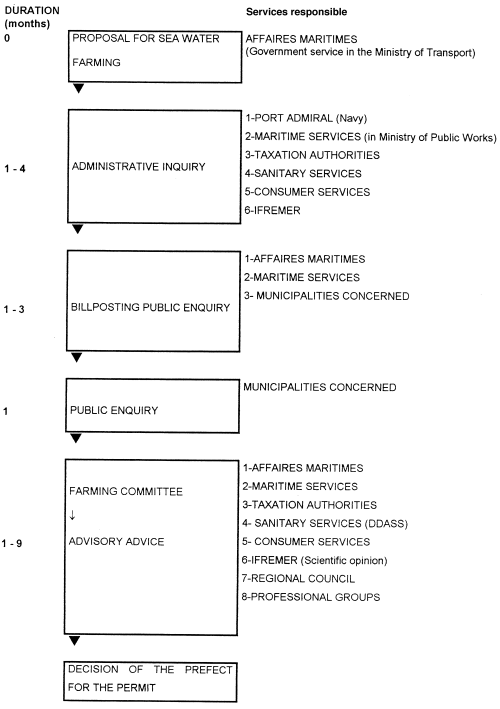
Legal procedure for obtaining a permit to exploit maritime public property. The first column represents the duration of steps
- •
the length of the procedure depends on the level of stakeholder involvement in the coastal zone concerned to reach consensus so that the licensing can proceed;
- •
the permit is delivered for a limited period of time (5–10 years) and can be re-examined after delivery, before expiring time. If the site has not been operational for three consecutive years the permit is withdrawn;
- •
environmental aspects are not directly involved;
- •
The procedure is controlled at the Departmental level, under the authority of the representative of the government (the Prefect);
- •
in order to have the request of the applicant for a permit examined, the petitioner has to have acquired skills from specific and approved training courses (which includes biology, technical aspects and management);
- •
the main component of the whole procedure is the decision of the Farming Committee, on which the local authorities and coastal zone users are represented.
The authorization
Figure 2 summarizes the procedure, which dates from 1810. There are two possibilities for each activity: an ordinary declaration below a given threshold or an implemented authorization above this threshold. For marine fish farming, this threshold is 20 tonnes per year. This procedure is not applicable to shellfish farming, which is considered by law to be an activity not liable to pollute. The Departmental Veterinary Service (DSV) is responsible for processing applications. This regulation was first developed for industrial pollution and was extended to agriculture in 1917, to freshwater aquaculture in 1977 and to marine fish farming in 1993. The central document is the Environmental Impact Study (EIS), aimed at protecting the natural environment. It includes a description of the environment prior to the project, a detailed description of the project, an assessment of the potential impact, and suggestions for monitoring and reducing this impact. Some specific requirements are mentioned in the authorization:
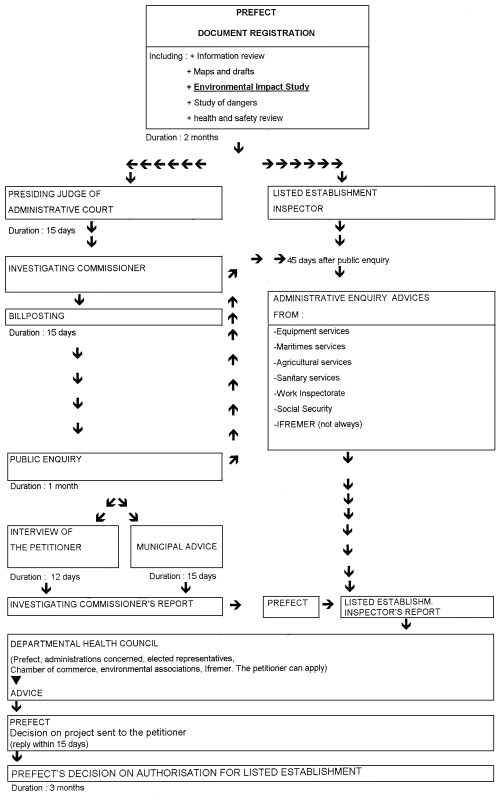
Legal procedure for obtaining an authorization to run a fish farm liable to cause pollution
- •
authorization to farm is given for a specified annual production of a given species and for a given company;
- •
a running chart of the operation must be provided by the petitioner;
- •
the authorization includes a permit to release waste and consume water;
Billposting in the offices of the city council concerned (for a period of 1 month) and legally required publication in newspapers is carried out by the local authorities.
This procedure, which can last from 7 to 18 months, follows the procedure for obtaining a permit. Thus the time required to obtain both can last from 11 to 35 months.
Procedure for the zoning of shellfish farming to protect the consumer
Given their feeding habits, shellfish can concentrate bacteria and chemical contaminants that could be harmful to the consumer. In 1994 the European Directive 91–492 was transposed into French legislation. It was later transposed as a decree (21/05/1999). It is based on the principle that the healthy state of the environment determines the healthy state of the end product. Given this axiom, no monitoring of the water body is required. It can easily be argued that bivalves are acting as sentinels of the natural environment and integrate the environment variations. Monitoring the environment itself may be not sufficient given the huge and rapid variations that could occur on the monitored parameters.
The procedure is based on the microbiological and heavy metals monitoring of shellfish reared in a specific production basin. Twenty-six measurements during one year have to be made on microbiology, and one per year for heavy metals (lead, cadmium and mercury). Ifremer, a Public Research Institute depending on the Ministry for Agriculture and Fisheries, is the acting body, under the responsibility of ‘Affaires Maritimes’. The initial zoning index (from A to D, see below) can be further modified depending on subsequent monitoring results, which rely upon the same annual procedure. The zone is determined by its hydrological characteristics and the technical and socio-economic aspects of the activity. The zoning is valid for no more than 10 years. The decision is made by the Prefect following an administrative enquiry. A given site may have a different zone value depending on the species farmed. When accidental events occur, the farm can be closed by the Prefect. These events are detected through specific networks (see next chapter) or self-monitoring.There are four indexes (Anonymous 1999):
- Class A:
shellfish farming and fishing are allowed. No purification in a purification plant is required. The thresholds are 230 Escherichia coli per 100 mL of crushed tissue, and 0.5, 2 and 2 mg per 1 kg of crushed tissue for, respectively, mercury, cadmium and lead.
- Class B:
the same as A class, but shellfish has to be purified in a depuration plant before sale. This is done in an approved dispatch centre. Fishing for leisure is prohibited. Threshold is 4600 E. coli per 100 mL of crushed tissue. They are not modified for what concern heavy metals.
- Class C:
only commercial fishery is allowed in the area, and trading is subject to intensive purification either in depuration plant or via re-stocking of the live product for 2 months in a Class A zone. Threshold is 46 000 E. coli per 100 ml of crushed tissue.
- Class D:
shellfish trading is prohibited from zone were these thresholds are exceeding.
Monitoring and compliance with environmental quality standards
The specificity of the marine environment, characterized in France by a high level of diversity, leads to difficulties in establishing environmental standards of quality that are valid for the entire country. Thus, the only clear legislation concerns the quality of the final product for shellfish, and this applies to the quality of the water in shellfish farming areas.
Shellfish
Three networks are managed by Ifremer in order to monitor water quality (RNO, National Observation Network), water microbiology (REMI, Microbiological Network) and potentially toxic phytoplankton species and their cell density (REPHY, phytoplankton Network). These networks are utilized to verify the everlastingness of the characteristics described during the zoning for shellfish farming process. The RNO network verifies that the concentrations of all heavy metals (particularly mercury, cadmium and lead) in mussels and oysters remain below the threshold levels (RNO also monitor heavy metal and organic molecule concentrations in sediments). It is operated by Ifremer, through a specific Contract, on behalf of the Ministry for Environment. The REMI measures the concentrations of coliforms, mainly E. coli, every month in the water and in the shellfish. It acts as an alert device. When coliform concentrations in the water start to become worrying, the monitoring frequency is enhanced to one sampling per week, and extended to total coliform and Salmonella concentrations. The frequency is also dependent on the zone indices (A, B, C or D). The REPHY measures the increase in the major dinoflagellates (Dynophisis, Alexandrium, Prorocentrum) and the presence of toxins in the tissues once a month (more often if there is a bloom). Three thresholds are utilized to ensure the edibility of molluscs: (I) 80 µg per 100 g of crushed tissue for PSP (Paralytic Shellfish Poison), according to the methodology described in Belin et al. 1996; (ii) 20 µg per g of crushed tissue for domoïque acid (ASP, Amnesic Shellfish Poison) through high-performance liquid chromatography measurement; (iii) no effect of DSP (Diarrhoeic Shellfish Poison) extracted from the digestive gland during the ‘mouse test’. This methodology is becoming modified to avoid the use of mice in the legislative framework by assaying the okadaïc acid, the causative agent (Honkanen et al. 1996).
These two latter networks are operated on behalf of the Ministry for Agriculture and Fisheries. It is part of the institutional role of Ifremer, besides its role in research and development.
To ensure sanitary quality of the shellfish production basins, a shellfish pathology network (REPAMO) was established in 1992 according to European Directive 91/67 of 1991 related to the free movement and sanitary safety device for shellfish. The European Directive 95/70 specifies the network activities, by obligation of each state, to control the sanitary bivalve quality. It also stated the Ifremer research unit for pathology and general immunology in La Tremblade as the reference laboratory for the International Office for Epizooty (IOE) and the European Union.The French coastline is therefore divided into 10 homogeneous areas. Each area is classified according to diseases which must be notified to the IOE (at present: Bonamia ostrea and Marteilia refringens on Ostrea edulis). The transfer of living flat oysters between the European areas is ruled according to approved (uninfected), nonapproved (infected) or areas where the status of infection is not known.
The monitoring of product quality to be marketed (whether they are depurated or not) is the responsibility of the DSV (stock recording, bacteriology and toxins) and involves self-monitoring and random checking by the DSV.
Fish
In fish farming, where the effect of the environment is less heavy than in shellfish farming, compliance with environmental objectives is assessed by EIS (Dosdat et al. 1996). As there are no compulsory standards, the environmental aspects are discussed by the Departmental Health Council, where all the socio-economic partners are represented and the admissible level of exploitation is defined. In the specific case of land-based fish farms, the quality of effluent water is often compared with the freshwater quality standards (see Table 2). In the case of sea cages, the required ‘local standard’ is then stated in the authorization decision by the Prefect. This is generally submitted to ‘sounded monitoring’ through a specific decree which also states on safety procedures, technical prescriptions (on sounds, lights, pathogen control, cleaning, welfare . . .), surveillance. The most common monitoring scheme involves a twice yearly survey of the benthos (redox potential, benthic fauna, deposited organic matter), a nutrient analysis of the water in the vicinity of the cages (oxygen, ammonia) and microbiological monitoring every 3 months. The fish farmer has to record every intervention and farming activity (standing stocks, food consumption and food ratios, input-output of fish, . . .). Accidental events (such as mortality and losses) and waste management (including dead fish, organic matter, fuel) must be recorded in documents placed at the DSV's disposal. At any moment and without any warning, the DSV has the power to inspect the farm as well as the environment. Generally, few thresholds are proposed for modification.
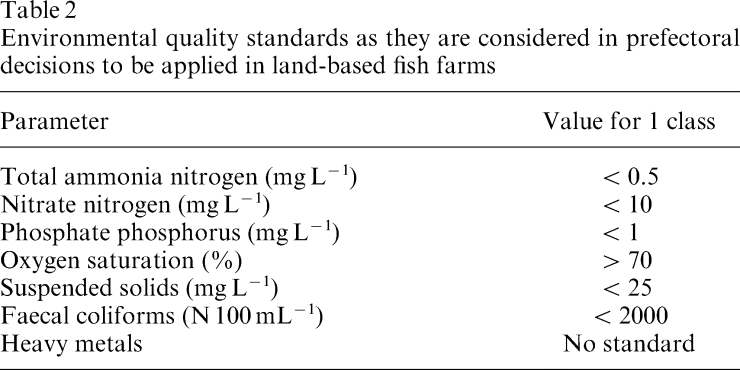
Again, the monitoring of products to be marketed is the responsibility of the DSV (stock recording, bacteriology and toxins). It also involves self-monitoring and random checking by the DSV.
Procedure for the use of veterinary products to fight diseases
Only fish farming is concerned with the use of veterinary products. Despite the considerable progress that has been made recently in improving vaccines, chemotherapy is still of great interest given the appearance of new pathogens. The legislation is applicable to antibiotics as well as vaccines or food additives. Since 1997, the study of residues excreted from these substances is compulsory under EU directive 92/18 and is an absolute prerequisite for obtaining a market licence (AMM). The study is carried out on behalf of the manufacturer and is divided into three phases (Blanc et al. 1997):
- Phase 1:
chemical analysis to determine the presence of a given chemical (or metabolite) in the natural environment after treatment of the fish. This gives the predictable environmental concentration (PEC). Its value is dependent on the different environmental compartments and varies with time.
- Phase 2:
this is conditioned by the results from Phase 1. Phase 2 is always carried out in the marine environment. It is designed to define the predictable no effect concentration (PNEC). As part of Phase 2, data on the elimination kinetics of the substance in different environmental conditions are required, and the acute toxicity levels for fish, shrimp larvae and algae must be determined. When the PEC/PNEC ratio is higher than 1, Phase 3 must be implemented.
- Phase 3:
further investigations are necessary, for example concerning gradual changes in the sediments, or the dispersion in the environment and the effect on free bacteria. These studies are performed in mesocosms.
In France, these veterinary products are only available though prescription from a registered veterinary surgeon. Very recently, a temporary utilization authorization has been launched in order to allow fish producers to use some veterinary products that have intermediary status before being authorized through an AMM.
Conclusions
The development opportunities for aquaculture in the coastal zone of France is limited because of difficulties in obtaining access to suitable sites and the natural resources. The lack of a standardized national plan for the site selection and for reserving sites suitable for aquaculture means that each new application faces a time consuming, complicated and costly process, particularly because of environmental concern. In many cases, the assessment demands by local governmental authorities are exaggerated when considering the actual risks involved. However, adjustments of environmental threshold values to the local environmental conditions are necessary and possible. Sufficient flexibility is also required in order to encourage technological innovations (such as water recycling which reduce environmental loads) (Dosdat and Gaignon 1997). In this respect, environmental quality standards at a national level are unrealistic to properly safeguard the environment while allowing a sustainable development of this activity. These adjustments are necessitated by the fact that the usual water-quality parameters used in freshwater are not relevant when considering large three-dimensional marine water bodies.
The standardization of the EIS procedures for the purposes of aquaculture is another tool that could be used to help this developing food production sector. The level of production at which an EIS is required has also to be harmonized across the EU in order to avoid distortion of competitive conditions. France decided on a very low level (20 t per year) whereas other countries state higher minimum production levels (100 t in Ireland) before a costly environmental assessment has to be initiated.
According to Morice et al. (1997), combining the two main licensing procedures (authorization and permit) into one would be a major legislative improvement that would simplify and shorten the time it takes to obtain both the authorization and the permit. The decentralization of the decision-making process and the involvement of numerous administrative bodies result in different legal interpretations which delay the procedures. The public inquiry could also be improved by providing the Commissioners with better training. Assigning a single local authority with the responsibility of the procedure would help to streamline it. This would then enable the authority to consider all farmed species, including molluscs and crustaceans, under the same framework, given their similar environmental impact.
A blanket recommendation could be that environmental problems are handled locally, according to predefined homogeneous coastal zones where the holding capacity (for fish farms) and/or the carrying capacity (for shellfish farms) could be theoretically defined using simulation models. This could be undertaken in a similar fashion as is suggested for the overall impact assessment studies designed to define the maximum permissible production level (ICES 1999). Holding and carrying capacity should be determined by the estimated assimilative capacity of the environment. Farms could be established in these zones in accordance with the ‘precautionary principle’. The extent of the programme for monitoring the environmental impact of the farms, determined by site-specific criteria as and when required by production development, would provide practical means to protect the environment. Such adjustments in the procedures have been successfully implemented in a few places in France (Cherbourg Bay, Jaudy Estuary, Corsican Lagoons) by the combined efforts of the local authorities and professionals. The problem of ‘who should deal with the wider issues’ then arises. Considering the many uses that are made of each natural environment along the French coast, frequently based on the same parameters (purification plants for example), and the interactions of all these activities, it would appear that only the federative power of the State is in a position to implement this task.
References
Authors' address: A. Dosdat, Institut Français de Recherche pour l'Exploitation de la Mer (Ifremer), Station de Palavas, 34250 Palavas-Les-Flots, France E-mail: [email protected]



